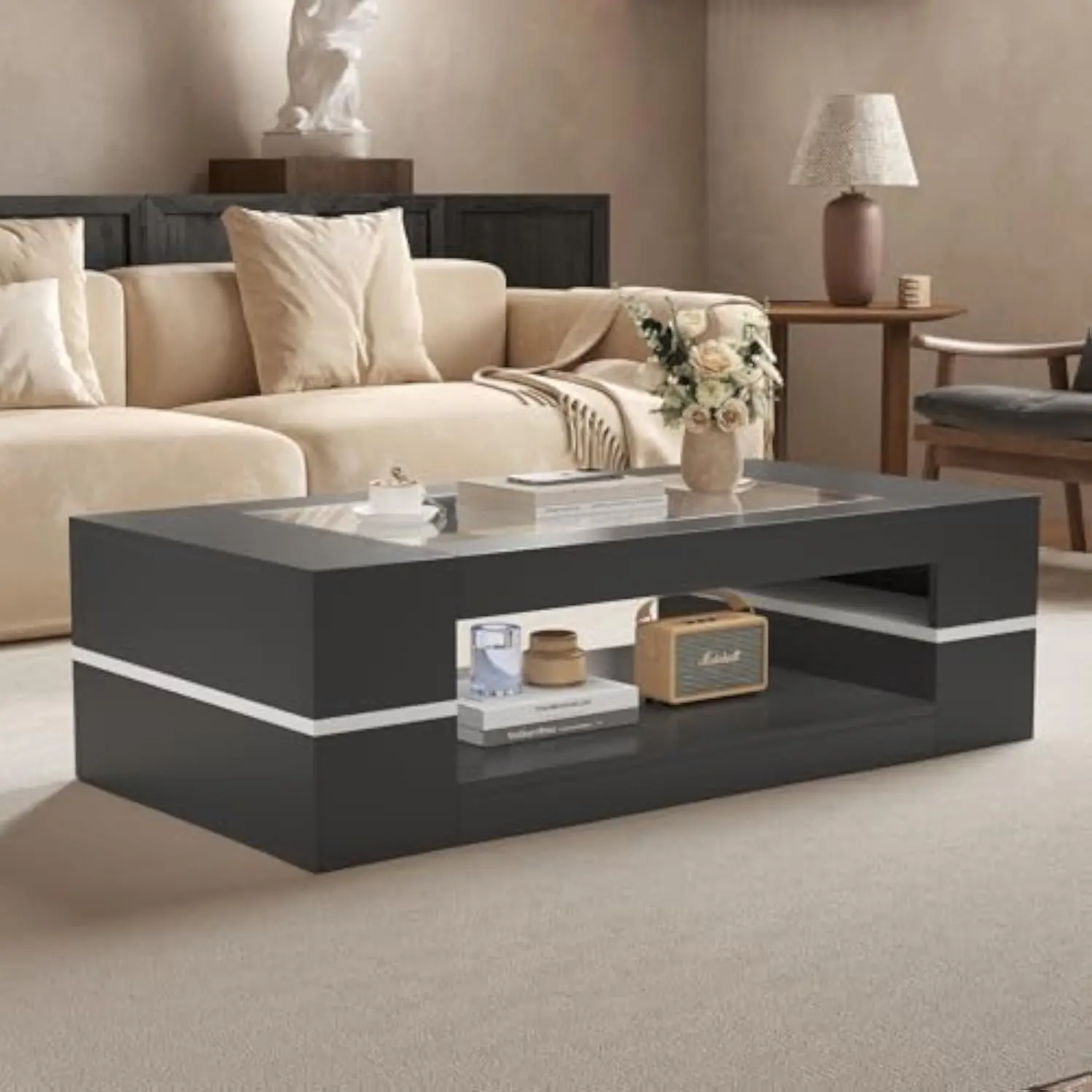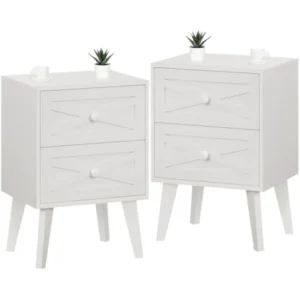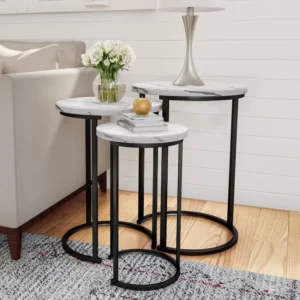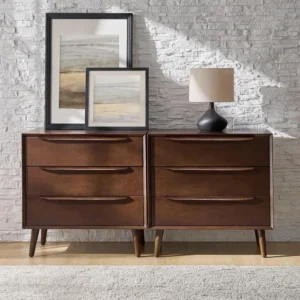Understanding the Small Space Challenge
Living in a small space presents unique furnishing challenges, especially when it comes to creating a functional and stylish living area. Whether you’re in a cozy apartment, a tiny house, or simply dealing with limited square footage, every piece of furniture must earn its place.
Coffee tables stand as essential anchor pieces in living rooms – they define the seating area, provide a necessary surface for daily living, and contribute significantly to the room’s overall aesthetic. However, in compact living spaces, finding the right coffee table becomes a careful balancing act between style, function, and spatial efficiency.
According to recent housing trends, urban apartment sizes have decreased by nearly 10% in the past decade, with the average studio now measuring under 500 square feet. This shrinking footprint makes thoughtful furniture selection more crucial than ever. The right mid-century modern coffee tables can transform a cramped area into an efficient, welcoming space that feels intentionally designed rather than merely squeezed together.
The challenge lies in finding pieces that don’t overwhelm the room visually or physically while still providing the functionality you need. Many homeowners have discovered creative ways to incorporate black mid-century coffee tables in small spaces, proving that size limitations don’t have to restrict style or utility.
With the right approach, a well-chosen compact coffee table can become the hero piece that brings your small living space together – offering function, style, and even clever storage solutions that maximize every square inch.
How to Properly Measure Your Space for a Coffee Table
Before shopping for your compact coffee table, accurate measurements are essential to ensure your new piece fits both physically and visually in your space. Taking the time to measure properly can prevent costly mistakes and disappointment.
Start by determining the dimensions of your seating area. The ideal coffee table should maintain 12-18 inches of clearance from surrounding seating—enough space to extend your legs but close enough to reach for a drink without stretching. This clearance is non-negotiable for comfortable movement and usability.
The classic proportion rule suggests your coffee table should be approximately two-thirds the length of your sofa. This creates visual harmony while providing adequate surface area relative to your seating. For height, aim for a table that’s 1-2 inches lower than your sofa seat cushions for comfortable use and visual balance.
Consider these measurement guidelines:
– Distance from sofa to coffee table: 12-18 inches
– Coffee table length: Approximately 2/3 of sofa length
– Height: 1-2 inches lower than sofa seat height
– Overall traffic flow: Minimum 30 inches for pathways around the furniture arrangement
When maximizing black mid-century coffee tables or any style in small spaces, accounting for traffic patterns becomes particularly crucial. Map out how people move through the room and ensure there’s sufficient clearance for comfortable passage—generally at least 30 inches for main walkways.
Don’t forget to consider the table’s relationship with other furniture pieces in the room. A coffee table should complement rather than compete with surrounding elements, creating a cohesive look that feels intentional despite space constraints.
Defining Your Coffee Table’s Primary Function
Before selecting a specific coffee table design, take time to identify what your table needs to accomplish in your space. In small living areas, each furniture piece often needs to perform multiple roles.
Display Surface
If showcasing decorative items, books, or plants is your priority, look for tables with adequate surface area and perhaps minimal storage underneath to maintain a lighter visual presence. Consider if you need space for practical items like remote controls or if the table will primarily display curated decorative objects.
Storage Solution
For many small space dwellers, storage becomes the critical function. If you need to conceal items like throws, magazines, or electronic devices, prioritize coffee tables with drawers, shelves, or lift-top mechanisms. This can significantly reduce clutter in a compact living area.
Work or Dining Surface
With more people working from home, many need their coffee table to double as an occasional workspace. Mid-century modern lift-top coffee tables offer ergonomic solutions by raising to a comfortable height for laptop use or casual dining, then returning to standard height when not in use.
Household-Specific Considerations
Homes with young children benefit from tables with rounded edges and sturdy construction. Similarly, pet owners might prioritize durability and materials that resist scratches or are easy to clean. Consider who uses your space daily and what special requirements they might have.
Creating a functional hierarchy helps prioritize features when you can’t have everything in one piece. Perhaps storage ranks above aesthetics, or perhaps a particular shape is non-negotiable for your floor plan. Identifying these priorities before shopping streamlines your decision-making process and leads to greater satisfaction with your selection.
Multi-Functional Coffee Tables That Maximize Small Spaces
In compact living spaces, furniture that performs multiple functions is worth its weight in gold. These versatile coffee table designs offer smart solutions for those needing to maximize functionality without sacrificing style.
Lift-Top Marvels
Lift-top coffee tables feature a surface that raises to create a comfortable work or dining height. These ingenious designs allow for:
– Ergonomic laptop use without hunching over
– Convenient dining without a dedicated dining table
– Hidden storage beneath the lifting mechanism
– Maintaining a standard coffee table appearance when not elevated
The mechanism typically operates smoothly with hydraulic systems that make adjustment effortless. When considering a lift-top design, check the raised height to ensure it works ergonomically for your needs.
Nesting Table Configurations
Nesting coffee tables provide tremendous flexibility for small spaces. These sets include two or more tables of varying sizes that can be tucked beneath one another when not in use. When entertaining or requiring additional surface area, simply slide them out to expand your usable space.
The beauty of nesting tables lies in their adaptability—they can function as:
– A traditional single coffee table when nested
– Side tables when separated around the room
– Expanded surface area for gatherings
– Tiered display areas for decorative items
For those with truly limited space, space-saving nesting coffee tables offer perhaps the most versatile solution, allowing you to adapt your living area to different needs throughout the day.
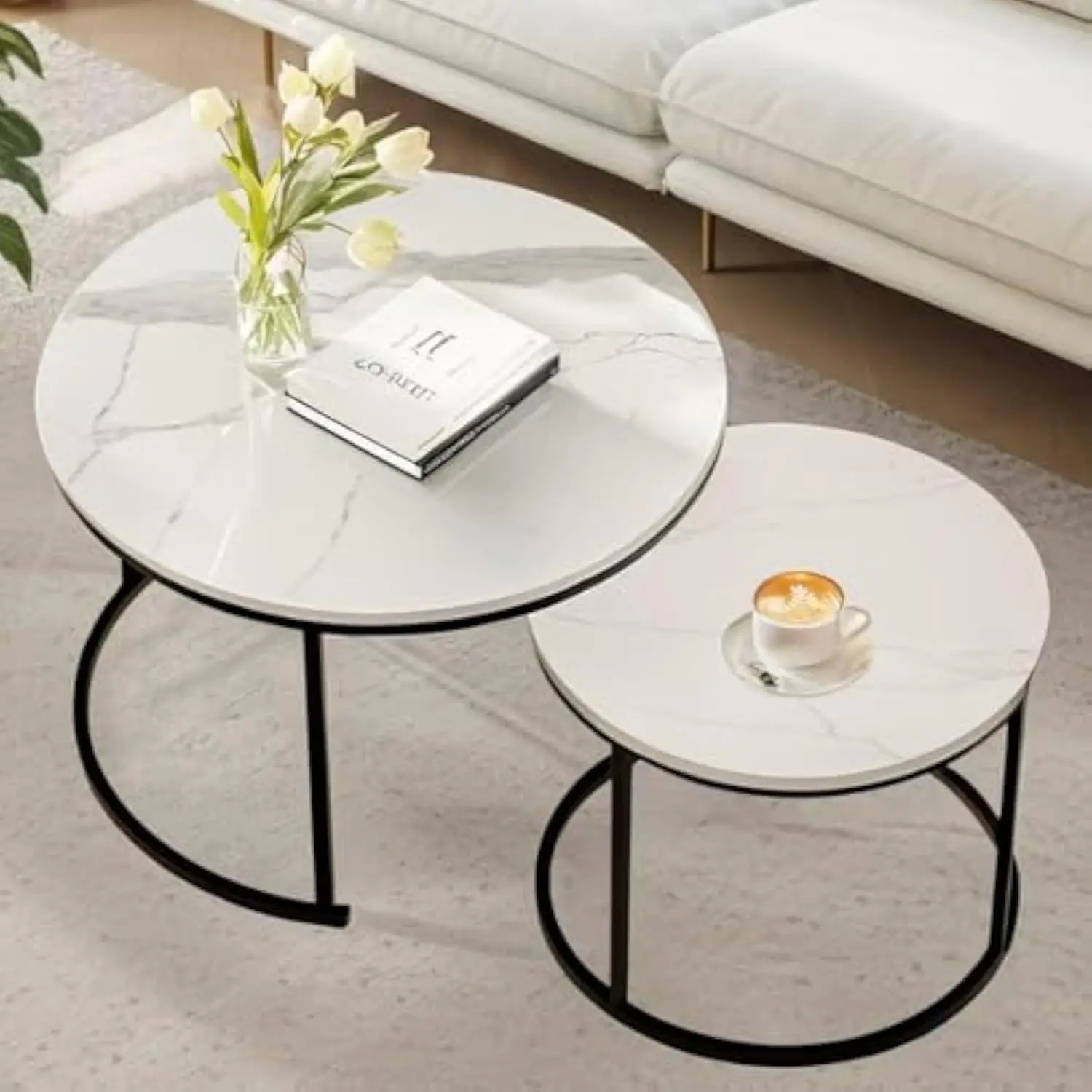
Storage-Integrated Designs
Coffee tables with integrated storage help combat the clutter that quickly overwhelms small spaces. Look for:
– Drawers that accommodate remote controls, gaming controllers, or small electronics
– Open shelving for books, magazines, and display items
– Hidden compartments for items you prefer to keep out of sight
– Lift-tops with deep storage wells for bulkier items
Ottoman Coffee Tables
These hybrid pieces triple as seating, storage, and table surface:
– Padded tops provide extra seating when guests visit
– Firm surfaces (often with trays) function as stable table surfaces
– Interior storage hides blankets, pillows, or seasonal items
– Lightweight design allows for easy movement when rearranging
When evaluating multi-functional options, consider ease of use—mechanisms should operate smoothly without struggle, and features should be practical for daily life rather than merely clever in concept.
Optimal Shapes for Small Space Coffee Tables
The shape of your coffee table significantly impacts how a small space functions and feels. Different configurations offer distinct advantages depending on your room layout and furniture arrangement.
Round and Oval Tables
Round and oval coffee tables have become favorites for small spaces for good reason:
– The absence of sharp corners improves traffic flow and prevents painful shin encounters
– Curved edges create more navigable pathways around the furniture
– The softer silhouette visually softens the room and creates a more inviting atmosphere
– People can gather more easily around a circular shape
Round coffee tables work particularly well with sectionals or L-shaped seating arrangements, as their shape complements the angle of the furniture while maintaining accessibility from all seating positions.
Square Tables
Square coffee tables make excellent use of space when:
– Your seating forms a perfect square arrangement
– You have a smaller love seat or apartment-sized sofa
– You need defined, symmetrical proportions
– You prefer a more structured look
In very small spaces, a square table with rounded corners offers a hybrid solution—the space efficiency of a square with the safety and flow benefits of rounded edges.
Narrow Rectangular Options
For narrow rooms or tight pass-throughs, a slim rectangular coffee table may be ideal:
– They can fit in spaces where wider tables would obstruct movement
– They provide adequate surface area while minimizing footprint
– They complement longer sofas or seating arrangements
– They can be positioned to direct traffic flow in a specific pattern
Small coffee tables with rectangular shapes often work well in studio apartments where space must be carefully divided between multiple functions.
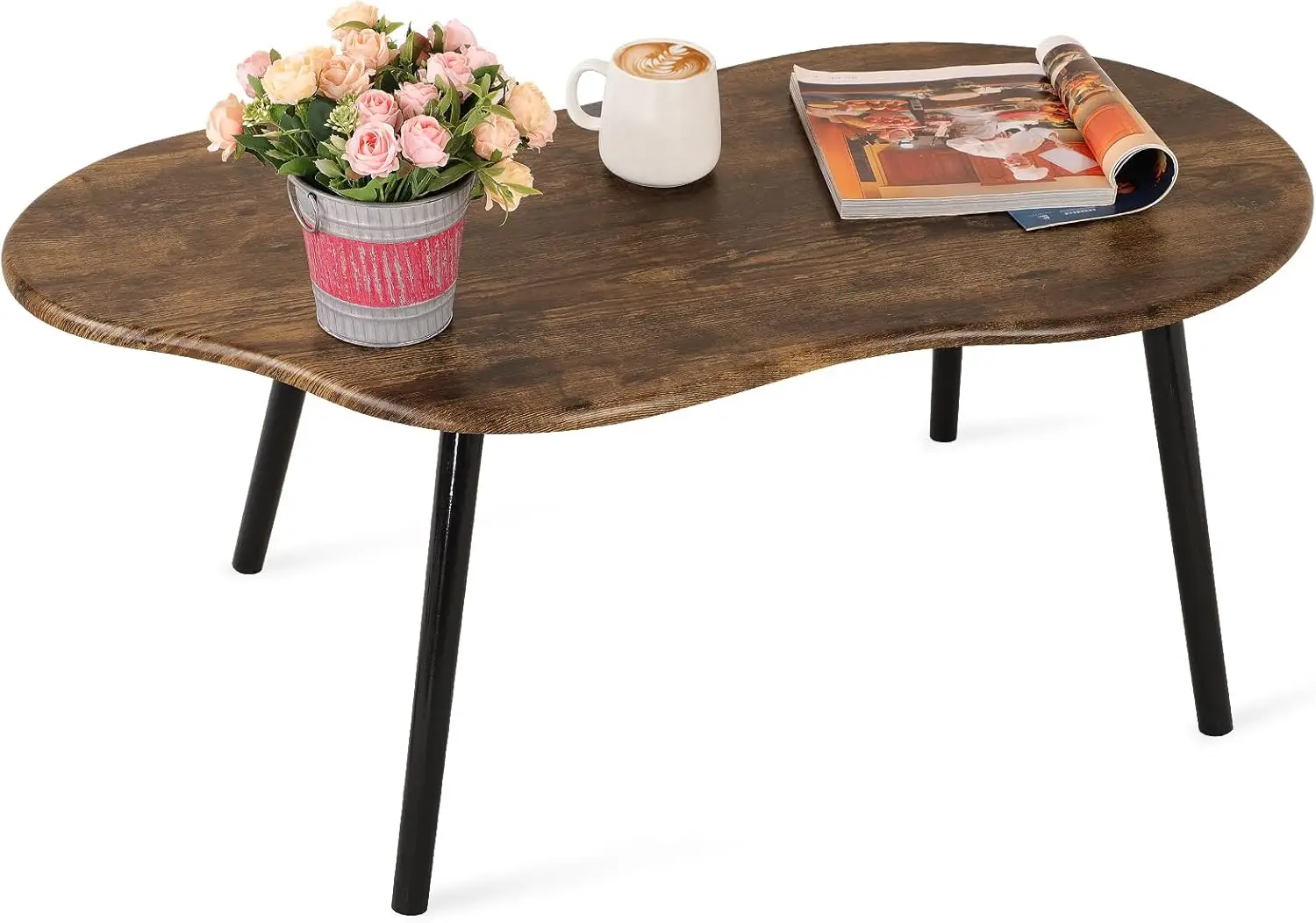
Organic and Free-Form Shapes
Coffee tables with organic, asymmetrical shapes can offer unique space solutions:
– Curved edges can hug the contours of unusual room layouts
– Non-standard shapes may fit where conventional tables won’t
– Their unique appearance adds visual interest and personality
– They often improve flow by eliminating hard corners
When selecting a shape, always consider how people move through your space. The ideal coffee table allows for natural movement patterns without creating obstacles or bottlenecks in your daily routines.
Space-Enhancing Materials for Compact Coffee Tables
The materials used in your coffee table can significantly impact how spacious a room feels. Certain materials create visual lightness, while others may make a small space feel more confined. Understanding these effects helps you make choices that enhance rather than diminish your living area.
Glass: Transparency Creates Space
Glass-top coffee tables remain a designer favorite for small spaces because:
– Transparency creates visual continuity, allowing the eye to travel through the piece
– Light passes through rather than being absorbed, brightening the room
– The reflective quality can bounce light around the space
– They reveal more floor area, creating a sense of openness
Various glass treatments offer different benefits:
– Clear glass maximizes the transparent effect
– Frosted glass provides some visual lightness while hiding what’s beneath
– Tinted or smoked glass adds sophistication while maintaining transparency
When considering glass coffee table ideas, remember that while visually light, glass requires regular cleaning to maintain its appealing appearance.
Acrylic and Lucite: The Nearly Invisible Option
These transparent plastics offer several unique advantages:
– Near invisibility creates an even lighter visual presence than glass
– Durability without the breakage concerns of glass
– Often more affordable than high-quality glass options
– Rounded edges and corners are common, improving safety
The main limitations involve scratching potential and occasional cleaning needs to maintain clarity.
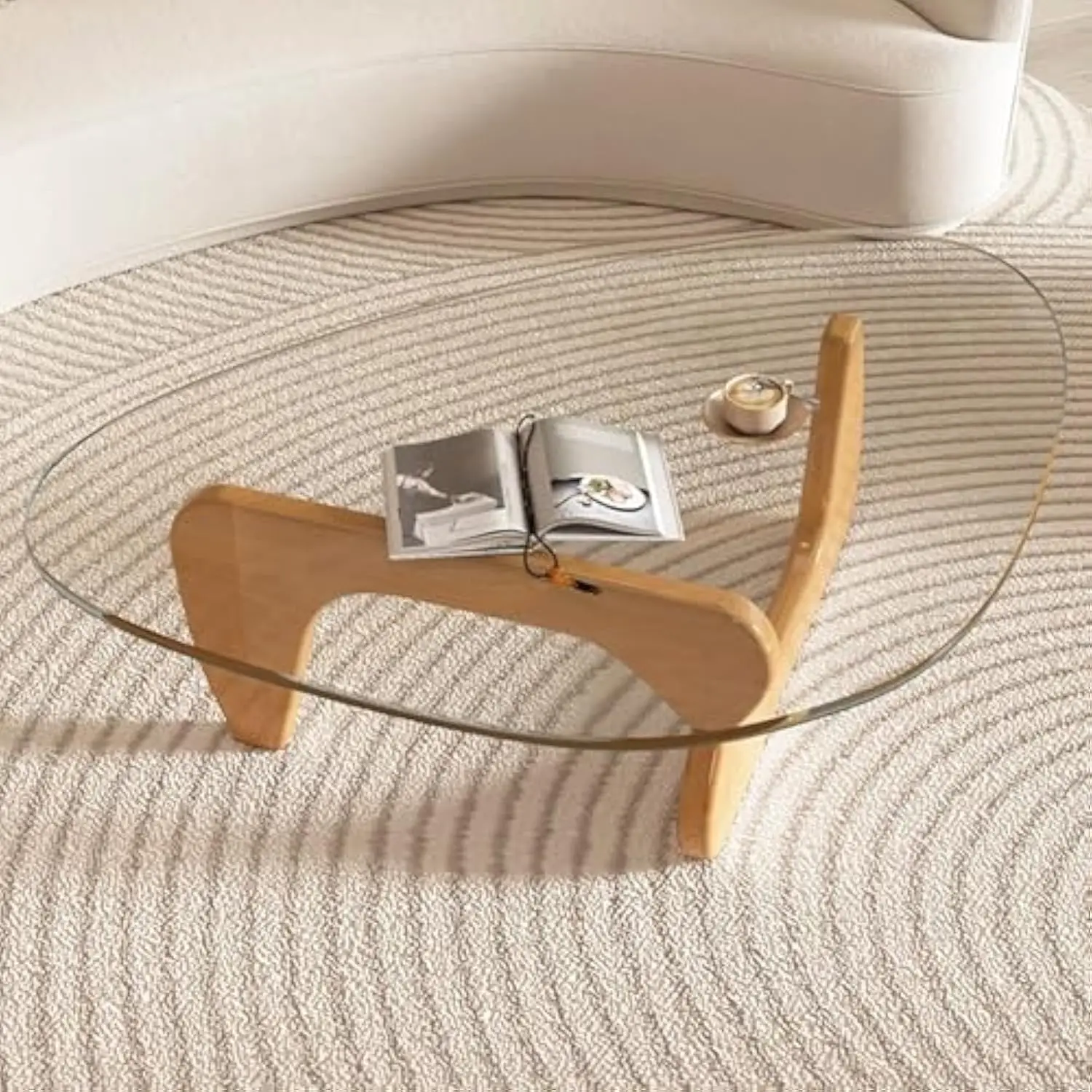
Light-Colored Woods
Natural wood brings warmth that glass and acrylic lack, but choosing lighter tones helps maintain visual spaciousness:
– Maple, ash, and light oak offer warmth without visual heaviness
– Blonde woods reflect more light than darker varieties
– The natural material adds texture and interest
– Wood provides durability and develops character over time
Slim Metal Frames
Metal-framed coffee tables with minimal profiles offer structural strength without bulk:
– Thin tubular or hairpin legs create minimal visual obstruction
– The strength-to-size ratio allows for delicate-looking yet sturdy pieces
– Metal reflects light, adding brightness to the space
– Frameworks with open designs maintain visual flow
Mixed Material Combinations
Some of the most effective small-space coffee tables combine materials strategically:
– Glass tops with wood or metal bases provide the best of both worlds
– Metal frames with small wood surfaces create visual interest without heaviness
– Contrasting materials add design sophistication while maintaining lightness
When selecting materials, consider not just appearance but practicality—some beautiful options require more maintenance than others, which may affect your long-term satisfaction with your choice.
Proportional Harmony: Sizing Your Coffee Table Correctly
Achieving visual balance between your coffee table and surrounding furniture requires attention to proportional relationships. Even the perfect style can feel wrong if sized incorrectly for your space.
The concept of “scale cascade” suggests furniture should follow a visual hierarchy, with larger seating pieces stepping down to medium-sized coffee tables, then to smaller accessories. This creates natural visual flow and prevents any single piece from dominating the space.
For small spaces, specific proportional guidelines help create harmony:
– Coffee table width should be approximately 2/3 the length of your sofa
– Allow 12-18 inches between the table edge and surrounding seating
– Table height should be level with or 1-2 inches below cushion height
– For sectionals, the coffee table should relate to the seating area, not just the main sofa portion
Common sizing mistakes that disrupt visual balance include:
– Tables too small to be functionally useful from all seating positions
– Oversized tables that dominate the room and impede movement
– Height mismatches that create awkward reaching or visual discordance
– Tables proportionally correct for the sofa but too large for the overall room
When styling a mid-century coffee table, remember that the proportions affect not just appearance but functionality. A table that looks appropriately sized but forces people to squeeze past it fails the practical test, regardless of its aesthetic appeal.
For unusually shaped rooms or non-standard furniture, you may need to adjust standard proportional guidelines. L-shaped or asymmetrical spaces often benefit from coffee tables that echo the room’s geometry while maintaining proper clearances.
Styling Compact Coffee Tables Without Creating Clutter
Decorating a small coffee table requires intentional restraint to avoid overwhelming the limited surface area. The goal is creating visual interest without sacrificing functionality or creating a cluttered appearance.
The Rule of Three
Professional stylists often recommend limiting decorative groupings to three items for visual harmony. On a compact coffee table, this might include:
– A small stack of books
– A petite plant or flower arrangement
– A decorative object or small tray
This approach maintains enough open space for practical use while still adding personality.
Tray Organization
Trays provide both visual structure and practical organization:
– Use a tray to contain smaller items like remote controls, coasters, or candles
– Select a tray that contrasts slightly with the table surface for visual definition
– Choose a size that occupies roughly 1/3 to 1/2 of the available surface
– Consider the tray shape—round trays soften square tables and vice versa
Vertical Styling
When horizontal space is limited, think upward:
– Stack books with an interesting object on top
– Use varying heights to create visual interest
– Consider a single tall, slender vase rather than multiple small items
– Ensure taller items don’t block sightlines across the room
When decorating mid-century coffee tables, maintain visual balance by distributing visual weight across the surface rather than clustering items on one side.
Seasonal Rotation
Rather than trying to display everything at once, consider rotating decorative items seasonally:
– Keep a small collection of favorite pieces to exchange quarterly
– This creates fresh interest without requiring more space
– Seasonal rotation allows for practical adaptability—more open space when needed
– Store off-season items in dedicated storage to maintain organization
The most successful small coffee table styling maintains at least 50% open, usable surface. This balances decoration with the table’s primary function as a practical surface for daily use.
Top 5 Space-Saving Coffee Table Designs Worth Considering
After exploring the principles of selecting compact coffee tables, let’s examine five exemplary designs that brilliantly solve small space challenges. Each offers unique benefits for different living situations.
1. Nesting Table Sets with Varied Heights
These versatile sets typically feature 2-3 tables that tuck neatly together when not needed:
– Perfect for fluctuating space needs—expand for gatherings, nest when not in use
– Often incorporate mixed materials like wood and metal for visual interest
– Provide flexible surface area that can be distributed throughout the room
– Work well in apartments where entertainment needs vary frequently
Ideal for: Social spaces with occasional entertaining needs and limited square footage.
2. Round Glass Coffee Tables with Slender Bases
This classic space-saving design continues to excel in small areas:
– Transparent surface creates visual spaciousness
– Absence of corners improves traffic flow
– Reflective surface bounces light to brighten the space
– Slim base maximizes legroom and underfloor visibility
Ideal for: Rooms with limited natural light or spaces that feel visually crowded.
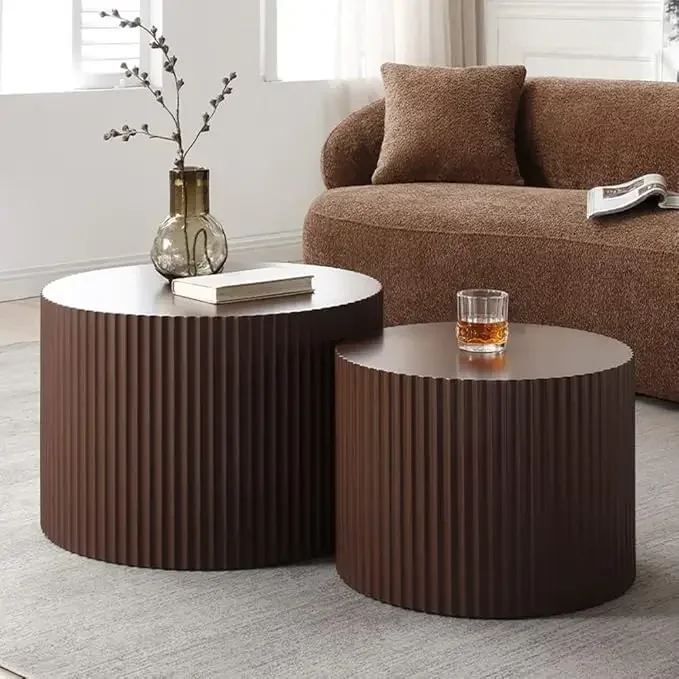
3. Storage Ottoman Coffee Tables with Tray Tops
These multifunctional pieces offer triple functionality:
– Hidden storage compartment for blankets, magazines, or games
– Comfortable extra seating for guests
– Stable surface when topped with a decorative tray
– Soft edges make them child-friendly and safe for tight spaces
Ideal for: Family rooms where versatility and storage are top priorities.
Mid-Century Modern End Table Sets of 2, Mid-Century Modern Square Side & End Tables, Mid-Century Modern White Side & End Tables
$348.24 Select options This product has multiple variants. The options may be chosen on the product pageMid-Century Modern Solid Wood Coffee Tables, Mid-Century Modern Teak Coffee Tables
$879.95 Select options This product has multiple variants. The options may be chosen on the product pageMid-Century Modern Danish Coffee Tables, Mid-Century Modern Oval Coffee Tables, Mid-Century Modern Solid Wood Coffee Tables
$390.05 Select options This product has multiple variants. The options may be chosen on the product pageMid-Century Modern Nesting Side & End Tables, Mid-Century Modern Nesting Table Sets, Mid-Century Modern Round Side & End Tables
Price range: $239.35 through $273.06 Select options This product has multiple variants. The options may be chosen on the product pageMid-Century Modern End Table Sets of 2, Mid-Century Modern Walnut Side & End Tables
Price range: $978.89 through $1,957.38 Select options This product has multiple variants. The options may be chosen on the product pageMid-Century Modern Coffee & End Table Sets, Mid-Century Modern Coffee Table Sets, Mid-Century Modern Oval Coffee Tables
Price range: $257.48 through $331.04 Select options This product has multiple variants. The options may be chosen on the product page
4. Lift-Top Coffee Tables with Internal Storage
The height-adjustable surface makes these particularly versatile:
– Surface raises to comfortable working/dining height
– Interior storage keeps essentials hidden but accessible
– Maintains a standard coffee table profile when not elevated
– Functions as a workspace without requiring a separate desk
Ideal for: Remote workers in studio apartments or anyone needing occasional workspace.
5. Slim-Profile Tables with Integrated Magazine Storage
These clever designs incorporate storage without bulk:
– Narrow silhouettes fit in tight passages
– Integrated slots or racks keep reading materials organized
– Clean lines maintain visual simplicity
– Often feature mixed materials for lightweight appearance
Ideal for: Reading nooks, narrow rooms, or spaces where conventional tables feel too bulky.
These innovative design inspirations offer solutions across various price points, proving that functional, attractive options exist regardless of budget constraints. The best choice depends on your specific space challenges and daily living patterns.
Clever Alternatives When Space Is Extremely Limited
Sometimes even the most compact coffee table won’t work in extremely constrained spaces. Fortunately, creative alternatives can provide similar functionality with an even smaller footprint.
C-Table and Side Table Combinations
Instead of one central coffee table, consider using multiple small tables:
– C-tables (also called sofa tables) slide partially under seating
– Small side tables arranged strategically provide surfaces where needed
– This approach allows for more flexible arrangement and easier movement
– Individual tables can be repositioned as needs change throughout the day
This solution works particularly well in spaces where traditional traffic patterns would make a central coffee table obstructive.
Wall-Mounted and Folding Options
For the ultimate space efficiency, consider tables that don’t permanently occupy floor space:
– Wall-mounted folding tables can be extended when needed
– Drop-leaf designs fold down to slim profiles when not in use
– These solutions free up valuable floor area in extremely tight quarters
– When closed, they create minimal visual intrusion
Repurposed Versatile Furniture
Thinking beyond conventional coffee tables opens up innovative possibilities:
– Storage cubes with trays on top serve multiple functions
– Small garden stools provide surfaces that can double as extra seating
– Vintage trunks offer both surface area and substantial storage
– Stacked floor cushions with a tray create casual, flexible arrangements
The Minimalist Approach
Some extremely small spaces function better without a traditional coffee table:
– Floor trays or floor cushions can provide necessary surfaces
– Wall-mounted shelves at arm height from seating offer drink placement
– Emphasizing side tables eliminates the need for central surface area
– This approach maximizes open floor space for movement
These alternatives challenge conventional thinking about what a living room “must” include. When space is truly at a premium, creative solutions that prioritize function over tradition often yield the most satisfying results.
DIY Custom Coffee Tables for Uniquely Challenging Spaces
When standard furniture won’t address your specific spatial challenges, creating a custom solution might be the answer. DIY approaches allow you to tailor dimensions, features, and aesthetics precisely to your space.
Simple Modifications to Existing Furniture
Transform readily available pieces with straightforward adaptations:
– Add casters to storage cubes for mobility
– Apply glass tops to interesting bases like ceramic garden stools
– Attach hairpin legs to vintage crates or boxes
– Refinish thrift store finds to match your décor
Materials needed: Appropriate attachments (legs, casters, hardware), basic tools, finishing materials.
Upcycling Opportunities
Give new life to unique finds with creative repurposing:
– Convert vintage suitcases with added legs
– Transform wooden crates with finished tops
– Repurpose industrial items like factory pulleys or gears as bases
– Refinish salvaged wood pieces for character and sustainability
The unique features of mid-century coffee tables like tapered legs and clean lines can be incorporated into DIY projects for designer style at modest cost.
Basic Construction Projects
For those with moderate woodworking skills:
– Create simple box frames with plywood and hardwood edging
– Build hairpin leg tables with dimensional lumber tops
– Construct nesting tables with varying heights
– Design modular pieces that can reconfigure as needed
Materials needed: Lumber appropriate to your design, measuring and cutting tools, finishing supplies, and hardware.
Budget-Friendly Approaches
Custom doesn’t have to mean expensive:
– Concrete pavers or rounds can create industrial-style bases
– Salvaged materials reduce costs while adding character
– Simple shapes require fewer cuts and less waste
– Unfinished options from furniture stores can be customized
Most beginner-friendly projects require minimal specialized tools and can be completed in a weekend, with costs ranging from $50-150 depending on materials selected.
How to Make a Dark Coffee Table Work in a Small Space
Conventional wisdom often suggests avoiding dark furniture in small spaces, but with the right approach, black coffee tables can add sophistication and anchor a room beautifully.
Creating Visual Balance
The key to incorporating darker pieces lies in balancing visual weight throughout the space:
– Pair dark tables with lighter seating or vice versa
– Create contrast with a light-colored rug underneath
– Balance with lighter elements at eye level, like artwork or shelving
– Ensure proper lighting highlights the table’s form
Grounding the Space
Dark coffee tables provide a visual anchor that can actually enhance spatial perception:
– They create a focal point that draws the eye and organizes the room
– The contrast helps define the seating area clearly
– They provide visual weight that makes other elements appear lighter
– They add sophistication and intentional design presence
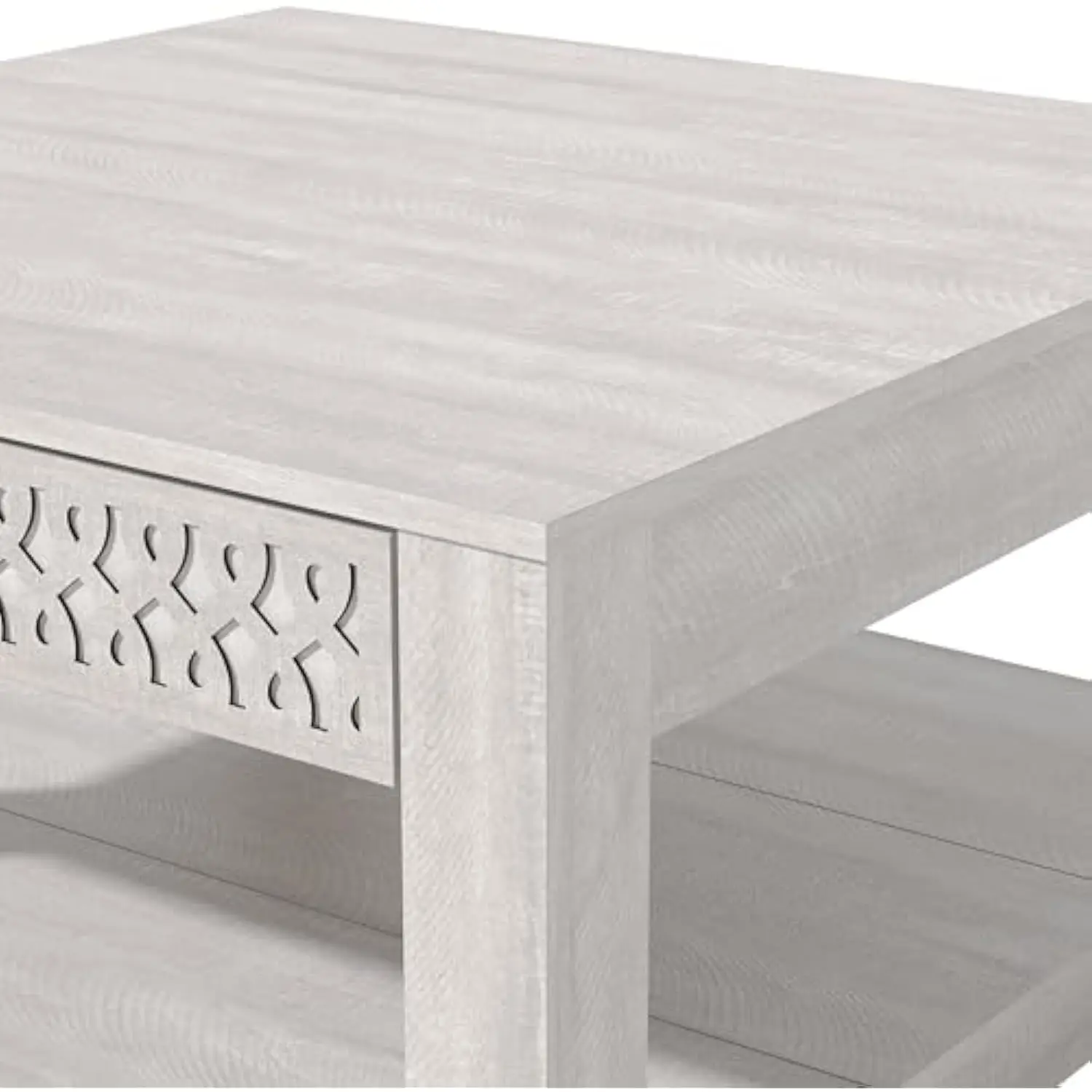
Material Combinations That Maintain Lightness
Integrating darker elements successfully often involves material mixing:
– Black or dark wood frames with glass tops create visual openness
– Slim profiles and raised legs keep pieces from feeling heavy
– Polished or lacquered finishes reflect light better than matte ones
– Mixed materials like metal and wood add visual interest while breaking up dark expanses
Dark tables can actually work exceptionally well in mid-century interiors, where the contrast between light and dark elements is a hallmark of the style. The key lies in creating deliberate contrast rather than trying to match everything in the space.
Lighting Considerations
Proper lighting dramatically impacts how a dark piece reads in a small space:
– Ensure adequate ambient lighting prevents the table from becoming a black hole
– Consider accent lighting that highlights the table’s form and texture
– Position the table where natural light will interact with it during daytime hours
– Use reflective accessories on the table to bounce light
With thoughtful implementation, a dark coffee table can become a sophisticated focal point that grounds your space rather than overwhelming it.
Essential Questions to Ask Before Purchasing a Compact Coffee Table
Making the right decision for your small space requires careful consideration before purchasing. Ask yourself these crucial questions to ensure satisfaction with your selection.
Is it truly proportional to my space?
Beyond basic measurements, consider the table’s visual weight in relation to your specific room:
– Will it maintain proper clearance even when chairs or ottomans are pulled out?
– Does the height work ergonomically with your existing seating?
– Is the shape appropriate for your traffic patterns?
– Will it feel balanced with surrounding furniture pieces?
How durable is it for my daily use?
Consider your household’s specific wear patterns:
– If you eat at your coffee table regularly, how will the surface hold up to spills and heat?
– Do you have children or pets that might test its structural integrity?
– Will the materials show wear quickly or develop a pleasing patina over time?
– Are replacement parts available if components like hinges or lifts malfunction?
How adaptable is it to changing needs?
The best furniture investments grow with you:
– Can it work in different room configurations if you rearrange?
– Would it still function if you move to a different home?
– Does it accommodate different usage patterns as your lifestyle evolves?
– Can it be easily modified or refreshed if your style preferences change?
What are the delivery and assembly considerations?
Small spaces often present logistical challenges:
– Will it fit through doorways, hallways, and stairwells?
– How complex is assembly, and do you have necessary tools?
– Can you manage assembly in limited space?
– If pre-assembled, can it be maneuvered into position?
The best mid-century coffee tables combine timeless design with practical features that accommodate real-life usage patterns. Prioritize quality construction in high-wear components like hinges, drawer glides, or lifting mechanisms if you’ll use these features frequently.
Frequently Asked Questions About Coffee Tables for Small Spaces
What’s the minimum size a coffee table can be and still remain functional?
For basic functionality, a coffee table should maintain at least 18-24 inches in width to hold essentials like drinks, remote controls, or a book. Length can be more flexible depending on your seating arrangement, but generally, 24-30 inches represents the lower functional limit for most households.
How do I determine the right height for a coffee table with non-standard seating?
The general rule is to align the table height with your seating’s cushion height or 1-2 inches below. For lower seating like floor cushions, tables 12-16 inches high work well. With higher seating like bar-height chairs, consider elevated tables around 20-24 inches high.
Are multi-level coffee tables good for small spaces?
Multi-level tables can be excellent space-savers as they provide different surface heights for various activities without requiring separate pieces. They work particularly well when you need dedicated spaces for decorative items and functional necessities, effectively separating these uses.
How can I ensure a coffee table is safe for children in a small space?
Look for tables with:
– Rounded corners and edges
– Sturdy construction that won’t tip easily
– Non-toxic finishes
– No pinch points in moving parts
– Secure closing mechanisms if storage is included
What’s the most budget-friendly way to get a quality compact coffee table?
Consider these approaches:
– Second-hand marketplaces for vintage finds
– Flat-pack furniture from major retailers
– Seasonal sales at furniture stores
– DIY projects using quality materials
– Floor models or open-box items at discount prices
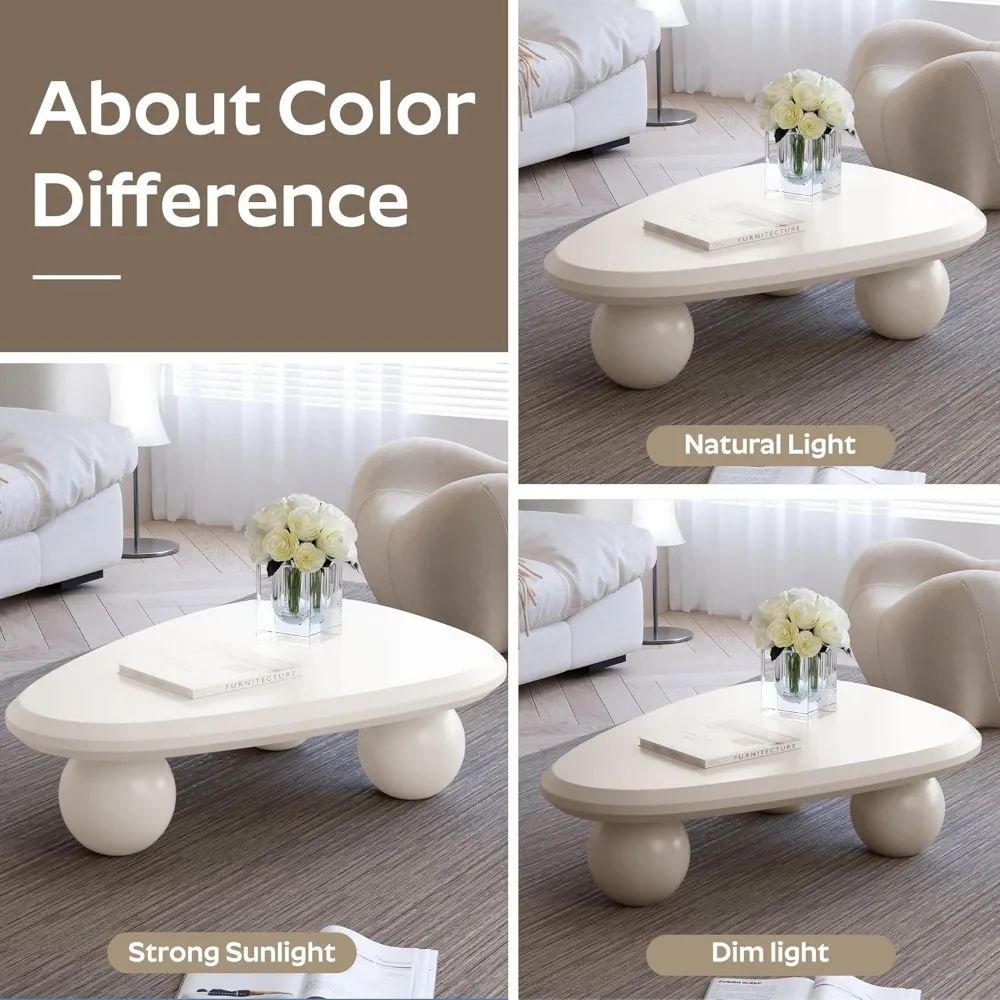
Understanding different coffee table styles helps you identify which designs inherently work better in compact spaces, guiding your shopping regardless of budget constraints.
Future-Proofing Your Coffee Table Choice
Making a thoughtful coffee table selection means considering not just your current circumstances but how your needs might evolve over time.
Adaptability to Different Living Situations
Choose pieces with flexibility built in:
– Height-adjustable tables accommodate different seating arrangements
– Neutral designs work across various décor styles
– Standard dimensions ensure compatibility with future furniture
– Modular or nesting designs adapt to changing space constraints
Investment Quality vs. Temporary Solutions
Consider the lifespan you expect from your purchase:
– Higher-quality materials typically offer greater longevity
– Classic designs resist looking dated as trends change
– Better construction withstands moves and reassembly
– Quality pieces often have better resale value
Sustainability Considerations
Environmentally conscious choices offer long-term benefits:
– Solid wood construction can last generations with proper care
– Repairable designs reduce waste
– Timeless styles won’t need replacement due to changing trends
– Quality craftsmanship reduces the environmental impact of frequent replacements
Design Longevity
Certain design elements tend to remain appealing over time:
– Clean lines rather than ornate details
– Classic proportions rather than extreme dimensions
– Materials with natural aging properties
– Versatile colors and finishes
Styles that complement mid-century modern design often possess remarkable staying power, as evidenced by their continuous popularity since their original introduction decades ago. These enduring designs often represent the best long-term investments.
The Mid-Century Modern Advantage for Small Spaces
Mid-century modern design principles offer particular advantages for small living spaces, explaining why this style continues to excel in compact environments.
The clean lines and organic shapes characteristic of mid-century design inherently maximize visual space. Unlike ornate traditional furniture that can feel heavy and space-consuming, mid-century pieces typically feature:
– Slender profiles that minimize visual bulk
– Tapered legs that create airiness beneath furniture
– Organic curves that improve flow and movement
– Proportions specifically designed for post-war smaller homes
This design movement emerged during a time when Americans were moving into smaller, more efficient housing—the post-WWII suburbs featured modest homes that required appropriately scaled furniture. Designers like Eames, Noguchi, and Nelson specifically created pieces to function beautifully in these more compact spaces.
Walnut coffee tables and other authentic materials common in mid-century design offer exceptional durability and aging characteristics. Unlike particleboard or composite materials, solid woods develop character over time, making them truly sustainable choices that improve rather than deteriorate with age.
The investment quality of well-made mid-century pieces offers long-term value. Their timeless appeal transcends fleeting trends, ensuring they remain stylish regardless of changing fashion. This makes them particularly suitable for those seeking to invest in quality rather than frequently replacing trend-based furniture.
Mid-century design’s emphasis on functionality means these pieces typically solve practical problems elegantly rather than sacrificing utility for appearance. This practical approach results in furniture that works as beautifully as it looks—the ultimate requirement for successful small space living.
At Hearth Forms, we recognize that thoughtfully selected coffee tables do more than fill space—they transform it, creating functional, beautiful living environments regardless of square footage constraints. The right compact coffee table doesn’t just fit your space; it enhances your daily living experience through a perfect balance of form and function.

